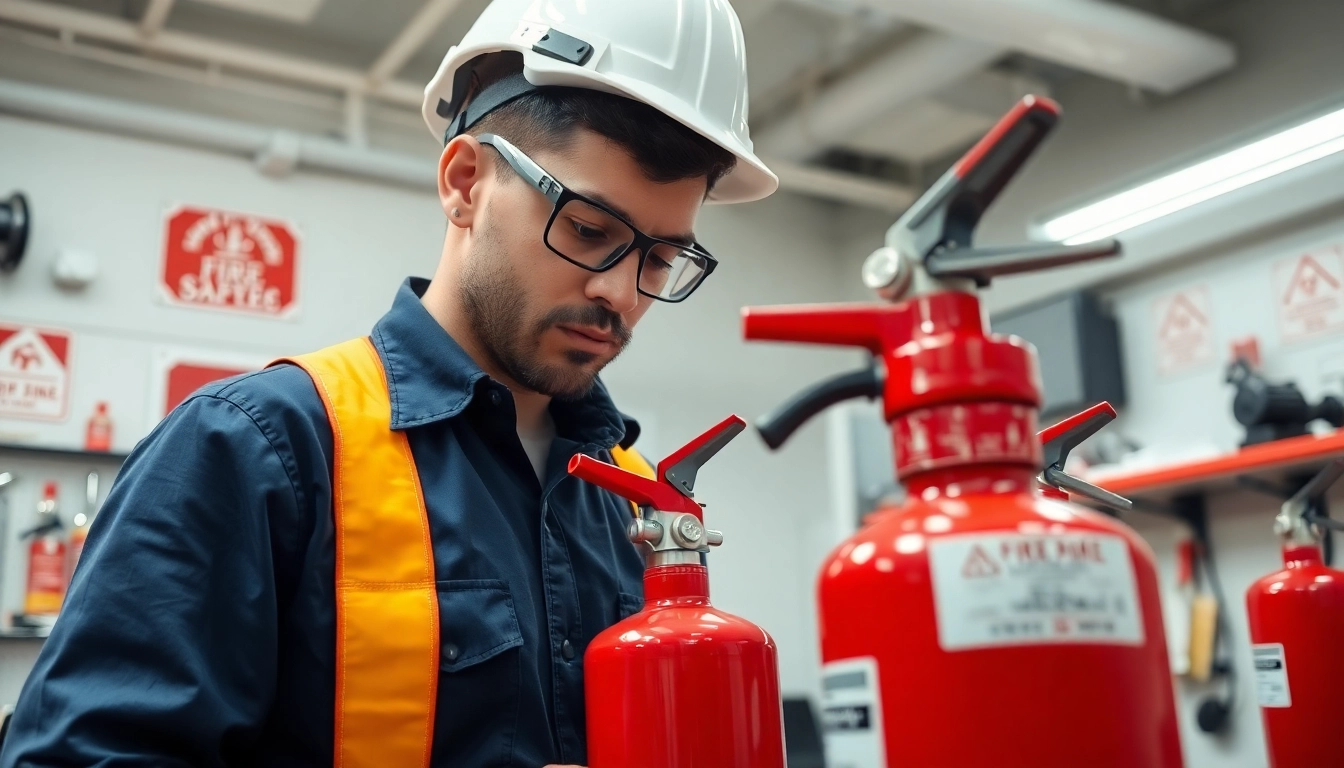Understanding Fire Extinguisher Maintenance
What is Fire Extinguisher Maintenance?
Fire extinguisher maintenance encompasses all the tasks necessary to ensure fire extinguishers remain operational and effective in case of an emergency. This involves periodic inspections, testing, recharging, and replacement when necessary. Fire extinguishers must be maintained according to established standards to comply with safety regulations and to protect lives and property. Regular fire extinguisher maintenance minimizes the risk of malfunction during a fire, ensuring that these vital tools can function when most needed. For detailed information on proper fire extinguisher management, consider exploring fire extinguisher maintenance.
Importance of Regular Inspections
Regular inspections are critical in maintaining the functionality and reliability of fire extinguishers. According to the National Fire Protection Association (NFPA) guidelines, fire extinguishers should be visually inspected every month and subjected to comprehensive examinations at least once a year. These inspections ensure that the extinguishers are properly charged, unobstructed, and free from physical damage. By adhering to these practices, building owners and safety managers can significantly reduce the risk of extinguishers failing during an emergency.
Key Regulations Governing Maintenance
Fire extinguisher maintenance is governed by a series of regulations and guidelines. The most referenced among these are the NFPA 10, which details the requirements for portable fire extinguishers. These regulations outline inspection schedules, maintenance procedures, and testing methods for various types of extinguishers. It is vital for businesses and property owners to stay updated on local and national laws regarding fire extinguisher maintenance to remain compliant and enhance safety in the workplace.
Common Fire Extinguisher Types and Their Maintenance Needs
Water, Foam, and Dry Chemical Extinguishers
These are among the most common types of fire extinguishers. Water and foam extinguishers are primarily used for class A fires, which involve ordinary combustible materials like wood or paper. They require regular inspections to ensure the integrity of the tank and nozzle. Dry chemical extinguishers, which can handle both class A and B fires (flammable liquids), must be inspected for chemical integrity and pressure levels. All these types should be recharged after every use and undergo a thorough maintenance check annually.
Carbon Dioxide Extinguishers
Carbon dioxide (CO₂) extinguishers are particularly effective for class B and C fires (flammable liquids and electrical fires). One of the unique maintenance needs for CO₂ extinguishers is checking the pressure level regularly to ensure it remains within the operable range. These extinguishers do not require regular refilling like other types; however, they should be tested annually for functionality and compliance with safety standards.
Wet Chemical Extinguishers
Wet chemical extinguishers are specifically designed for kitchen fires involving cooking oils and fats. They require specialized maintenance because they involve chemical agents that need to be replaced periodically. Maintenance includes inspecting the nozzle and nozzle assembly for clogs, checking the seals, and ensuring the pressure gauge operates correctly. Like others, these extinguishers must also be subjected to annual inspections and recharges as specified by the manufacturer.
Steps for Effective Fire Extinguisher Maintenance
Monthly Inspection Checklist
Conducting a monthly inspection consists of a few straightforward steps, which should include:
- Confirming that the extinguisher is easily accessible and not obstructed by furniture or objects.
- Checking the pressure gauge to ensure it is in the green zone for full readiness.
- Inspecting the body for signs of damage such as dents, rust, or leaks.
- Ensuring that the pin and tamper seal are intact.
- Verifying that inspection tags are up-to-date.
These steps are essential in ensuring that the extinguisher will perform effectively during a fire emergency.
Annual Maintenance Procedures
In addition to monthly checks, fire extinguishers must undergo a more in-depth annual maintenance procedure, often requiring the expertise of a certified professional. Annual maintenance typically includes:
- A thorough external examination to review the overall condition of the extinguisher and its components.
- Checking the operation of the pressure gauge and verifying the weight of the extinguisher.
- Testing the nozzle and other release mechanisms to ensure functionality.
- Rechargeable extinguishers must be weighed and checked for proper chemical content.
- Documentation of results and any required actions taken during the inspection.
Meeting these requirements not only fulfills legal compliance but also helps to guarantee the safety of the premises.
When to Replace Your Fire Extinguisher
Knowing when to replace a fire extinguisher is crucial for ensuring safety. Factors that necessitate replacements include:
- Extinguishers that have been used and are not rechargeable must be replaced immediately.
- Extinguishers that show visible signs of damage, corrosion, or physical wear should be replaced.
- Expired extinguishers, typically noted on the cylinder itself, should be replaced promptly.
- After a specified number of years (usually 5-15), extinguishers must be replaced or undergo extensive internal inspection.
Regularly updating extinguishers ensures they are in optimal working condition, especially in high-risk environments.
DIY vs Professional Fire Extinguisher Maintenance
Benefits of Professional Services
While some maintenance tasks can be performed by business owners or designated staff, hiring a professional service offers numerous benefits, including:
- Expertise in compliance with local regulations and standards, ensuring no steps are missed.
- Specialized training in identifying potential issues that may not be visible to untrained eyes.
- Provision of necessary documentation for inspections to satisfy legal requirements.
- Save time and reduce the liability associated with maintaining fire safety equipment.
Using professional services can ultimately improve the safety of the workplace environment.
Common Mistakes in DIY Maintenance
Attempting to conduct DIY maintenance may lead to certain pitfalls, including:
- Overlooking manufacturer guidelines or local regulations, leading to compliance issues.
- Failing to recognize signs of wear or malfunction, which can compromise extinguisher effectiveness.
- Incorrectly charging or inspecting extinguishers, leading to improper functionality during an emergency.
- Inadequate documentation or record-keeping, which is critical for safety audits and inspections.
Awareness of these mistakes can help organizations prioritize professional inspection services over DIY efforts.
How to Choose a Certified Inspector
Choosing a certified fire extinguisher inspector is critical for ensuring safety compliance. Here are some tips to guide this process:
- Look for certifications from recognized bodies such as the National Fire Protection Association (NFPA) or similar organizations.
- Verify that the inspector has adequate insurance to cover any liabilities during the inspection process.
- Read reviews or seek recommendations from similar businesses regarding their experiences with specific professionals.
- Ensure the inspector is knowledgeable about local fire codes and regulations, as these can vary widely.
Taking these steps can help ensure that the organization is working with a knowledgeable and reliable inspector.
Maintaining Compliance and Safety Standards
Understanding Local Fire Codes
Fire codes are designed to establish minimum safety standards for fire prevention and protection within a given area. Understanding local fire codes is essential for maintaining compliance.
These codes often dictate the type, quantity, and placement of fire extinguishers based on the occupancy type and hazard classification. Businesses should be familiar with both national standards and particular provisions of local regulations to ensure their safety measures are effectively implemented.
Documenting Your Maintenance Activities
Documenting all inspection and maintenance activities is not only essential for compliance but also helps track the functionality of fire extinguishers over time. Documentation should include:
- The results of all monthly inspections and any corrective actions taken.
- A record of annual maintenance by certified professionals.
- The dates of recharge or replacement.
- Identification tags that show inspection dates and the name of the inspector.
Proper documentation makes it easy to illustrate compliance during inspections and audits, protecting the organization from potential liabilities.
Emergency Preparedness and Fire Extinguisher Readiness
Emergency preparedness goes beyond simply having fire extinguishers available; it involves ensuring that all employees understand how to use them effectively. Training sessions on fire safety and extinguisher use should be held regularly, especially during onboarding for new staff.
Additionally, businesses should establish clear emergency protocols, including evacuation routes and assembly points, to ensure that everyone knows what to do in the event of a fire. Fire drills can help cultivate a culture of safety and preparedness within the organization.
Conclusion
Fire extinguisher maintenance is an essential component of fire safety management, ensuring that these life-saving devices operate properly when needed. By adhering to established maintenance schedules, regulations, and employing professional services as necessary, organizations can significantly reduce the risks associated with fire emergencies. Continuous education and training for all staff regarding the proper use of these extinguishers further enhance safety efforts, leading to a safer environment for all. Regular checks, meticulous documentation, and understanding local fire codes can ensure a comprehensive approach to fire safety and compliance.



